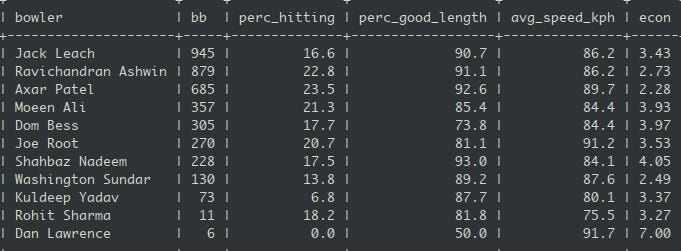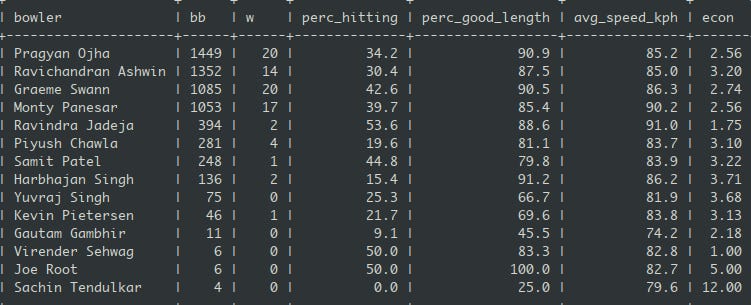A Tale Of Two Series
The story of why India are probably going to win this series 3-1, and why India lost the 2012-13 series 1-2 in three charts.
As I write this brief note during the Tea break on Day 3 of the 4th Test, England are 91/6 and need 69 more to make India bat again. They have played the extra batsman in this Test and consequently still have their last recognized batting pair - Dan Lawrence and Ben Foakes - batting. There’s a chance that Lawrence and Foakes could produce an epic double century stand here and turn this Test around. But its unlikely. I want to point out the difference between this series, which India will probably win 3-1 and the 2012-13 series which England won 2-1 (the 4th Test at Nagpur was drawn).
The ball-tracking records of both these series are available on the BCCI’s media website1. The tables below summarize how often each bowler attacked the stumps, how often each bowler hit a good length (between 3 and 6 metres for a spinner), and the average speed at which each bowler bowled.
There is a tendency among observers of the game to regard batting as an independent action in cricket even though batsmen can only face what the bowlers offer. Bowlers are the only independent actors in Test cricket. They shape all possibilities. Tests are decided by the capacity of the bowlers to shape these possibilities.
Shahbaz Nadeem is a very accurate bowler. He hit a good length 93% of the time in the 1st Test. He’s arguably a better bowler than Jack Leach. But he’s much slower through the air. His average speed in the first Test was 84.1 kmph. And he hits the stumps 17.5% of the time (roughly once every over). India replaced him with Axar Patel who is equally accurate (hits a good length 92.6% of the time) and is significantly quicker (average speed 89.7 kmph - 5.6 kmph quicker than Nadeem). Patel is also taller than Nadeem and has a much higher release. Patel, in other words, is much harder to step out to, or to sweep. Absent these two options, there’s nothing for the batsmen to hit. Consequently, Patel has gone for 2.28 runs per over in the series. Nadeem (granted, some of it was because England were chasing quick runs in the 3rd innings), went for 4 an over.
R Ashwin is sui generis. He has bowled at an average speed of 86.2 kmph and attacked the stumps with 22.8% of his deliveries, and gone for 2.7 runs per over. His control of flight, and his ability to get the ball to drift make him a testing proposition. The fact that he misses his length in only 9% of his deliveries (essentially once every 2 overs) despite never bowling the same bowl twice in a row makes it look at times, as though the batsman is just his marionette.
By comparison, Dom Bess and Moeen Ali - England’s two off-spinning options in this series, when considered together, have missed their length 20% of the time (once every 5 balls). They’ve attacked the stumps 19.6% of the time, and they’ve conceded 3.95 runs per over. Joe Root - a part-time off spin bowler - also misses his length once every 5 balls, but he’s been the quickest spinner on show in the series. England’s off-spinning options in this series have been of the quality of a part-timer.
In the 2020-21 series, India’s batsmen have had many more freebies compared to England’s batsman. It is no surprise that England are very likely to lose 1-3.
In 2012-13, England won the series 2-1. In that series, they had two top class spinners in Graeme Swann and Monty Panesar. Panesar was as quick as Axar Patel (he average 90.2 kmph over the series). And while he missed his length more often than Patel, he attacked the stumps on 40% of his deliveries. Swann was slower, more accurate and attacked the stumps on 42% of his deliveries. But contrast, the Indian spinners were both slower than Panesar and attacked the stumps significantly less (34.2% of Pragyan Ojha, and 30.4% for Ashwin). The record of Samit Patel (England’s spare spinner in those Tests) suggests that England had a concerted plan of attacking the stumps and forcing the Indian batsmen to score off the stumps. Panesar gave England the control in 2012-13 which Axar Patel has provided for India in 2020-21.
The gap between the Indian and English spinners in 2012-13 was narrower than it is in the 2020-21 series. But England’s spinners were still better. India’s batsmen in that series were Pujara, Sehwag, Gambhir, Tendulkar, Kohli, Dhoni and Yuvraj Singh. And they could only do what the England spinners allowed them to do. That’s why England won at Eden Gardens and the Wankhede Stadium on that tour after losing in Ahmedabad.
Test matches are decided by bowlers. They are shaped by what the bowlers allow batsmen to do. This is why teams which bowl bad overs and bad balls less often usually win Test matches. And teams which are able implement attacking ideas in the field better win Test matches. The batsmen are secondary characters.
England are currently 109/7.
Records for the 1st day of the current series are unavailable. Apart from this, records for almost all deliveries are available.




